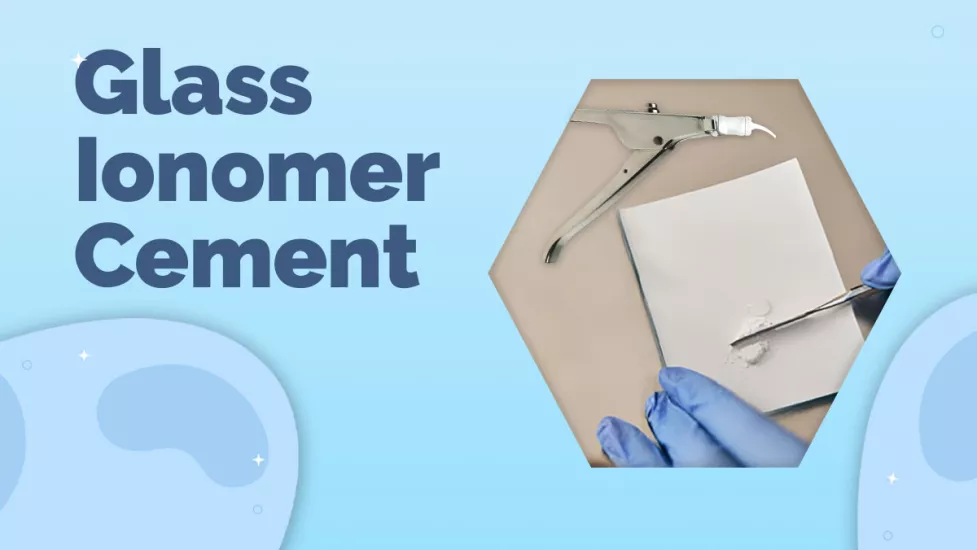Glass Ionomer Cement
09/23/2023
INTRODUCTION
After the deleterious effect of mercury became known in 1950s worldwide, the world observed its reduction at various levels like products, processes as well as industries1. People came up with the alternate options in dental material industry that were resinous material i.e. composite and polyalkenoate based that was GIC.
GIC material was first introduced by Wilson and Kent in 1972as new translucent dental filling material for cervical restorations.(3) GIC emerged and gained popularity because of interesting properties such as biocompatibility, bioactivity, fluoride release, excellent coefficient of linear thermal expansion/contraction and modulus of elasticity, as well as being the only restorative material capable of chemically bonding to the tooth structure4.In early days of invention of GIC, the material was not strong enough for posterior restoration but with the evolution in the property of the material of powder and liquid by addition of various component and element, it is now used at all places i.e. anterior posterior of deciduous and permanent tooth.
Composition of Glass Ionomer Cement:
- The glass ionomer cement is supplied into powder liquid system and is mixed manually. The powder is mainly fluoro-aluminosilicate glass.
- The liquid is an aqueous solution of polyacrylic acid. Polyacrylic acid is copolymerized with carboxylic acid, maleic, tartaric, and itaconic acid to regulate the viscosity and stabilize the liquid. The liquid exhibits a thixotropic behaviour: its thickness can be reversed by shaking or warming the bottle. Other supply modes include capsules like GC Equia Forte fill, twin syringes, and single bottle water settable form (freeze-dried polyacrylic acid added to GIC powder).
MANIPULATION:
- Glass Ionomer Cement is mixed manually using agate spatula on mixing pad which is generally supplied by manufactured company.
- Powder and liquid are taken in proportion instructed by the manufacturer.
- The powder is divided into two equal increments. The liquid is dispensed later to prevent increased viscosity by water loss on exposure to the environment.
- The first increment of powder is added to liquid using a folding motion and mix for 15 sec.
- The second increment is added to adjust the consistency, the mix will be glossy in appearance which shows free carboxylic acid which are free to bond chemically with the tooth.
Now, with the evolution the glass ionomer cements are also coming into capsule like Equia Forte fil which are just activated by vibrating into automixer. The time and proportion of powder liquid is predetermined by the manufacturer. The paste comes out of capsule are already mixed GIC paste.
CLASSIFICATION:
BASED ON CLINICAL APPLICATION:
- Type I – Luting cement used for cementation of crowns and bridges.
- Type II – Restorative cement used for aesthetic fillings
- Type III – GIC used as liners and bases
- Type IV – GIC used as pit and fissure sealants
- Type V – GIC used for orthodontic cementation
- Type VI – GIC is used for core build-up in highly mutilated teeth
- Type VII – Fluoride releasing light-cured GIC.
- Type VIII – GIC for atraumatic restorative treatment (ART)
- Type IX – GIC used for Paediatric and geriatric restorations.
Application in dentistry
- Tooth Restoration: GIC is commonly used for restorative procedures in dentistry. It can be employed for the minimally invasive restoration of decayed or damaged teeth. GIC is especially useful in paediatric dentistry for filling cavities in young patients, as it releases fluoride, aiding in the prevention of further decay.
- Luting Cement: Dentists use GIC as a luting cement for cementing dental crowns, bridges, inlays, and onlays. Its adhesive properties ensure a secure bond between the restoration and the tooth structure.
- Orthodontic Applications: GIC is also utilized in orthodontics for bonding orthodontic brackets to teeth. Its fluoride-releasing properties help prevent enamel demineralization during orthodontic treatment.
- Pit and Fissure Sealants: Dentists often use GIC as a pit and fissure sealant material. This helps protect the vulnerable chewing surfaces of molars and premolars from decay.
- Core Build-Up: In cases where significant tooth structure is lost due to trauma or decay, GIC can be used as a core build-up material to provide support for a dental crown.
- Temporary Restorations: GIC is ideal for creating temporary restorations while permanent restorations (like crowns or bridges) are being fabricated in a dental laboratory.
Unique property of glass ionomer cement:
- Fluoride Release: One of the outstanding features of GIC is its ability to release fluoride ions over time. This property helps in remineralizing the adjacent tooth structure and prevents further decay.
- Biocompatibility: GIC is well-tolerated by oral tissues, making it suitable for a wide range of dental applications.
- Adhesion to Tooth Structure: GIC forms a strong chemical bond with enamel and dentin, providing excellent retention for restorations.
- Thermal Expansion: Its thermal expansion properties closely match those of natural tooth structure, reducing the risk of restoration fractures.
- Aesthetic Options: GIC is available in various shades to match the natural tooth colour, making it suitable for visible restorations.
How to avoid glass ionomer restoration failure?
- Proper Diagnosis and Treatment Planning: Accurate diagnosis and treatment planning are essential to determine the suitability of GIC for a specific case. Assess the extent of tooth damage or decay and select the appropriate restorative material.
- Moisture Control: GIC is sensitive to moisture during placement. Ensure the treatment area is adequately isolated, and use rubber dams or cotton rolls to keep the field dry.
- Adequate Tooth Preparation: Prepare the tooth structure according to the manufacturer’s guidelines. Ensure that the cavity margins are clean, well-defined, and free from any debris.
- Matrix and Retention: Use a matrix band to shape the restoration properly. If necessary, provide mechanical retention features such as undercuts to enhance the bond.
- Proper Mixing Technique: Follow the manufacturer’s instructions for mixing GIC. Ensure that the powder and liquid are mixed thoroughly and consistently to achieve the correct working consistency.
- Timely Placement: Work efficiently to place the GIC within the recommended working time. Avoid overworking the material, as this can lead to poor adaptation and reduced strength.
- Careful Condensation: Condense the GIC carefully into the prepared cavity, making sure there are no voids or air bubbles. Use appropriate instruments for condensation.
- Adequate Light Curing (if applicable): For certain GIC materials, light curing may be necessary to achieve optimal properties. Ensure that the restoration receives adequate light exposure according to the manufacturer’s recommendations.
- Proper Finishing and Polishing: After the GIC has set, use appropriate instruments to finish and polish the restoration. Smooth any rough edges and ensure proper occlusal alignment.
- Patient Education: Educate the patient on proper oral hygiene practices and the limitations of GIC restorations. Emphasize the importance of regular dental check-ups and maintenance.
- Follow-up and Monitoring: Schedule follow-up appointments to monitor the restoration’s integrity over time. Early detection of any issues can prevent more significant problems.
- Consider Material Selection: Depending on the specific clinical situation, consider the type of GIC being used. Some GICs are formulated for specific applications, such as high-strength GIC’s like EQUIA Forte HT, GC Gold Label Hybrid etc. for load-bearing areas.
- Maintain Good Records: Maintain detailed records of the restoration, including the type of GIC used, mixing ratios, and any specific techniques employed. This information can be valuable for future reference and follow-up.
By adhering to these guidelines and best practices, dental professionals can minimize the risk of failure in Glass Ionomer Cement restorations, leading to better patient outcomes and long-lasting dental treatments.
One of the pioneer and leading company with most trusted user for introducing glass ionomer cement into dentistry is GC. GC leads the way in glass ionomer technology and are well known for the expertise and progress in the field. Certainly! Here’s a description of some Glass Ionomer Cement (GIC) products by GC Dental, a trusted name in the dental industry known for its high-quality dental materials:
1. GC Gold Label II / GC Fuji II
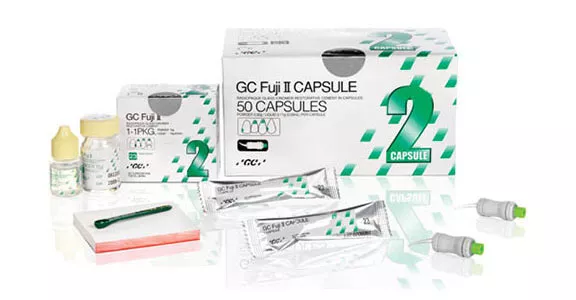
Features
- Chemically cured glass ionomer restorative cement with optimal handling for class III and V restorations.
Advantages
- Resistant to moisture
- Long-term stability in the mouth
- Excellent marginal seal
- Good radiopacity
- Facilitating post-operative diagnosis
- Intrinsic adhesion to dentine and enamel
- No etching, no bonding
- Hydrophilic
- No need for rubber dam
2. GC Gold Label II LC / GC Fuji II LC
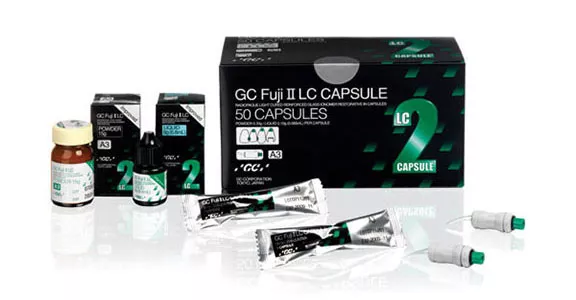
Features
- Light Cured Glass Ionomer Cement
- GC Gold Label II LC / GC Fuji II LC is the world-wide leading light-cured glass ionomer cement. Although designed primarily as a restorative material for use in Class III, V and deciduous teeth.
- GC Gold Label II LC / GC Fuji II LC is a multipurpose material, with secondary indications such as liner, base and core build-up.
Advantages
- Higher filler loading
- Significantly improved abrasion resistance
- Excellent aesthetics and polish ability
- Good radiopacity
- Self-adhesive to tooth structure
- No etching, no bonding
- Hydrophilic
- Very good results in areas where rubber dam is difficult to use, cavity margins are in dentin and enamel prisms cannot be properly etched.
- Available in 11 translucent VITA shades
- Smooth, porosity-free surface after sealing with GC G-Coat Plus
3. GC Fuji VII / GC Gold Label VII
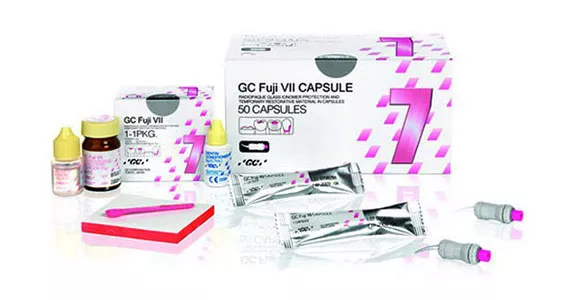
Features:
- Glass Ionomer Sealant & Surface Protectant
- GC Fuji VII / GC Gold Label VII is the revolutionary glass ionomer sealant and surface protectant.
- It is fantastic at keeping young patients’ teeth cavity-free.
- There is no isolation or bonding agent required.
- It works in a moist field and seals over immature enamel or non-cavitated lesions.
- The self-bonding, high fluoride releasing GC Fuji VII creates a strong, acid-resistant fused layer.
Advantages:
- Seals and protects tooth enamel.
- Six times more fluoride than any other sealant
- Releases fluoride for up to 24 months to help prevent decay from acid and bacteria.
- Fuji VII/ GC Gold Label VII White is for fully erupted teeth; Fuji VII / GC Gold Label VII Pink offers a visual indicator that is ideal for newly erupted molars.
4. GC Gold Label IX
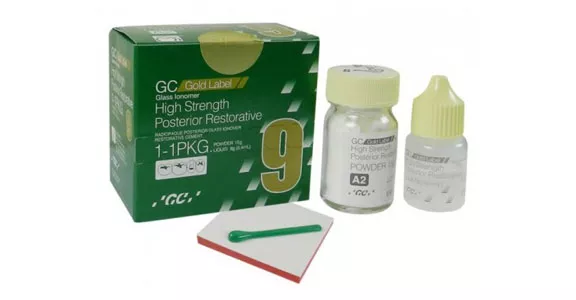
Features:
- High Strength Radiopaque Posterior Glass Ionomer Restorative
- A high strength strontium-based glass ionomer restorative for use in posterior teeth.
Indications for Gold Label IX
- Class I and small Class II restorations in non-load bearing areas
- Class I and Class II restorations in deciduous teeth
- Transitional restorations
- Base / Core build-ups
Advantages:
- Chemical adhesion to the tooth structure with high fluoride release capacity
- Thermal expansion similar to the tooth structure
- Good radiopacity due to high strontium content
- High compressive and flexural strength
- 60% higher wear resistance than conventional glass ionomers make Gold Label IX strong enough for use in posterior teeth.
5. GC Gold Label IX Extra / Fuji IX Extra
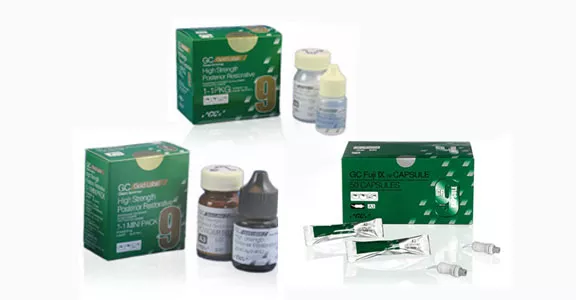
Features:
- Packable Glass Ionomer
GC Gold Label IX Extra/ Fuji IX Extra’s new SmartGlass filler takes glass ionomer to a whole new level:
- EXTRA fast setting – Finishing in only 2 1/2 minutes.
- EXTRA high fluoride release – Six times higher than the current Fuji IX GP FAST
- EXTRA translucency – Allows improved aesthetics and shade matching.
- EXTRA strong – Maximizes durability for optimum performance.
6. GC Gold Label Hybrid
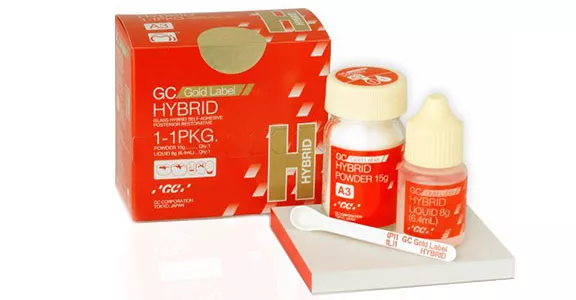
The next generation of hand-mixed, self-adhesive posterior restorative that features GC Advanced Glass Hybrid technology.
Advanced Glass hybrid technology is the combination of two types of Fluoro-Almino-Silicate (FAS) glass and two types of polyacrylic acid.
INDICATIONS
- Class I and Class II restorations in deciduous teeth.
- Non-load bearing Class I and Class II.
- Intermediate restorative and base material for heavy stress situations in Class I and Class II cavities using the sandwich laminate technique.
- Class V and root surface restorations.
FEATURES
- Core build-up.
- High mechanical strength and durability
- High Aesthetics
- More translucency and suitable to colour of around tooth tissue
- High acid resistance ability
- High moisture tolerance
- Efficient fluoride releasing
7. GC EQUIA Forte HT
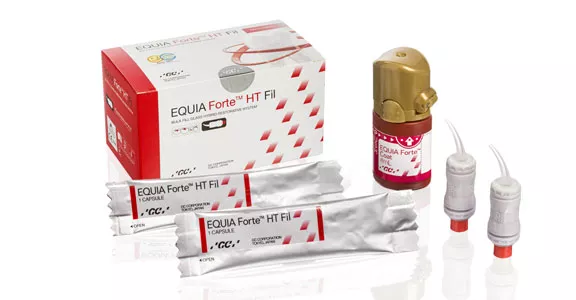
Bulk fill glass hybrid long term restorative system
FEATURES
The new EQUIA Forte® HT is a long-term bulk fill restorative system with enhanced mechanical properties, superior fluoride release, sound marginal seal and excellent handling. This makes EQUIA Forte HT a versatile and durable restorative solution, ideal for patients of all ages, including paediatric, geriatric and high-risk caries patients.
Indication
- Class I restorations
- Stress bearing Class II restorations (see technique guide for cavity preparations)
- Non-stress bearing Class II restorations.
- Intermediate restorative
- Class V and root surface restorations
- Core build up.
Highly Versatile Applications
- Amalgam replacement / alternative
- Restoration of molar incisor hypo mineralised teeth (MIH)
- Restorations for geriatric and paediatric patients
- Restoration of posterior teeth in high-caries risk patients
Conclusion
In conclusion, Glass Ionomer Cement (GIC) stands as a remarkable material in the field of dentistry, offering a wide range of applications and unique properties that contribute to successful restorations and preventive treatments. Its versatility, biocompatibility, and fluoride-releasing abilities make it an asset for dental professionals and a boon for patient oral health.
To avoid failures in GIC applications, it is imperative to follow best practices diligently, from accurate diagnosis and treatment planning to proper moisture control, tooth preparation, mixing, and placement. Additionally, maintaining good patient communication, conducting regular follow-ups, and staying updated with the latest advancements in GIC technology are all essential components of ensuring the long-term success of GIC restorations.
As dental technology continues to evolve, Glass Ionomer Cement remains a trusted material that not only restores teeth but also contributes to the overall well-being of patients by preventing further decay and offering aesthetic solutions. Its future in dentistry appears promising as researchers and practitioners continue to explore its potential and refine its applications. Ultimately, GIC is more than just a dental material; it’s a cornerstone of quality dental care and patient satisfaction.
References:
- 1. Azevedo FA, Nascimento ES, Chasin AM. In: Azevedo FA, Chasin AA, orgs. Metais: gerenciamento da toxicidade. São Paulo (SP): Atheneu; 2003. p. 299-352.
- Almuhaiza M. Glass-ionomer Cements in Restorative Dentistry: A Critical Appraisal. J Contemp Dent Pract 2016;17(4):331-336.
- United Nations Environment Programme (UNEP). Minamata Convention on Mercury. Text and Annexes. Oct. 2013. [cited 2017 Aug. 03]. Available from: http://www.mercuryconvention.org/Portals/11/documents/Booklets/COP1%20version/Minamata-Convention-booklet-eng-full.pdf
- Sidhu SK, Nicholson JW. A review of glass-ionomer cements for clinical dentistry. J Funct Biomater. 2016;7(3). pii: E16.
- Sidhu SK, Nicholson JW. A review of glass-ionomer cements for clinical dentistry. J Funct Biomater. 2016;7(3). pii: E16.
- Gurgan S, Kutuk ZB, Ergin E, Oztas SS, Cakir FY. Clinical performance of a glass ionomer restorative system: a 6-year evaluation. Clin Oral Investig. 2017;21(7):2335-43.
- Nicholson JW. Maturation processes in glass-ionomer dental cements. Acta Biomater Odontol Scand. 2018;4(1):63-71. [PMC free article] [PubMed]
- Sidhu SK, Nicholson JW. A Review of Glass-Ionomer Cements for Clinical Dentistry. J Funct Biomater. 2016 Jun 28;7(3) [PMC free article] [PubMed]
- Neha Sikka1; Melina Brizuela Glass Ionomer Cement StatPearls [Internet ast Update: March 19, 2023.
- Lad PP, Kamath M, Tarale K, Kusugal PB. Practical clinical considerations of luting cements: A review. J Int Oral Health. 2014 Feb;6(1):116-20. [PMC free article] [PubMed]

Dr Garima Singh graduated from army college of dental sciences in November 2022. She has one year of experience as medical underwriter in Niva Bupa Health Insurance Company. She also have experience in private practice . She is currently working with GC India as product specialist in Marketing Scientific and Academic Affairs Department.

